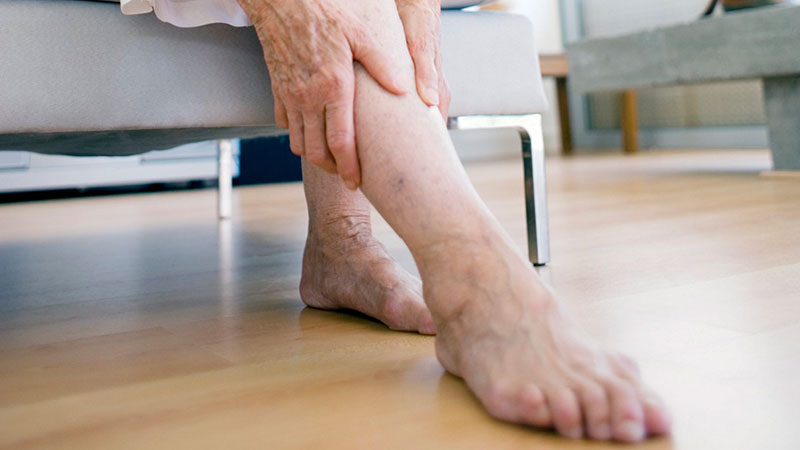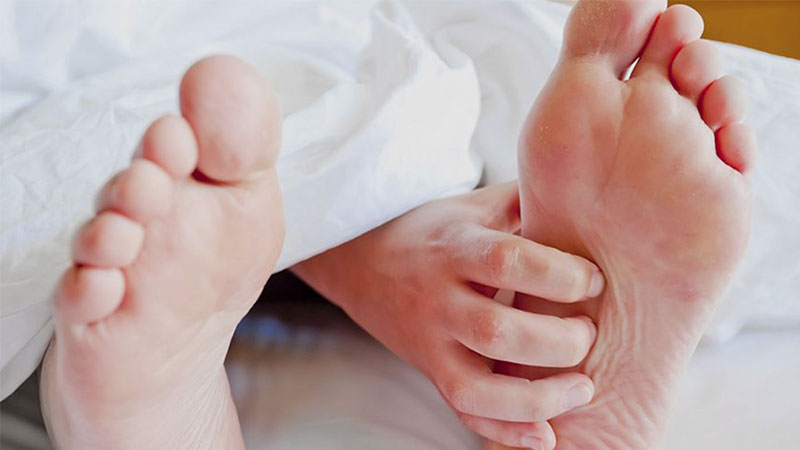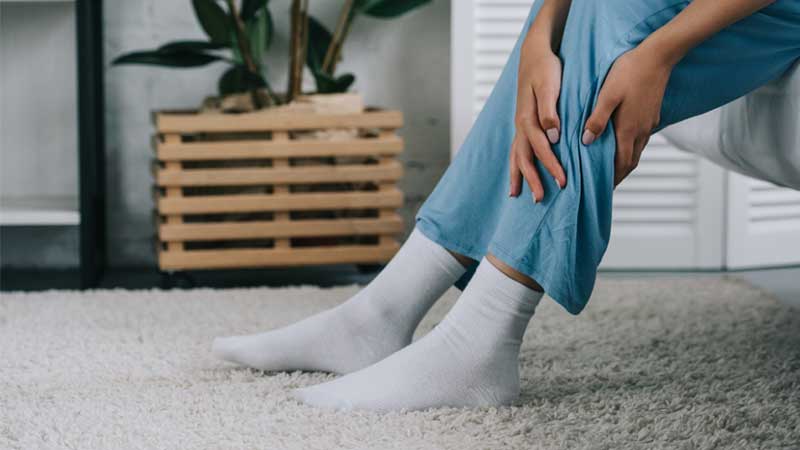There are various kinds of foot disorders and problems such as smaller toe conditions, heel conditions, etc. Each condition was examined completely in the previous articles. Thus in the following context we will explain Restless legs syndrome (RLS). RLS, also known as Willis-Ekbom disease, is a kind of disorder which leads to an intense motivation to move. It also brings feelings explained as creeping, itch, creeping, pulling, throbbing, inflammation, or gnawing. Restless legs syndrome exists in families and is also connected with lots of situations and diseases and medicines.
What is Restless Legs Syndrome?

Restless legs syndrome is a sleep disturbance that leads to an intensive, sometimes intolerable provocation to move the legs (even the arms and body). It happens along with other sentiments in the limbs demonstrated as creeping, paining, tugging, crawling, throbbing and etc.
These feelings often happen when lying in bed or sitting for a long time, like while driving or sitting at a theatre. RLS usually happens in the evening and makes it hard to fall asleep. Most of the time people with this disorder prefer to walk around and move their legs in order to release the inconvenient sensations.
Exactly similar to big toe conditions, people with different ages, even children, could suffer from RLS.
RLS has been discovered to be a genetic disorder in some cases. It means parents who suffer from RLS might pass it to their children. Till 92% of people with RLS possess a first-degree relative with the syndrome. These people will develop signs earlier in life (formerly age 45) than those patients with RLS without the genetic connection.
On top of the genetic origin, lots of medic disease are closely connected with the expansion of RLS, including:
- Shortage of iron
- Uremia
- Having hypothyroidism
- Having depression
- Suffering from fibromyalgia, Parkinson’s and kidney disease
- Having diabetes and suffering from diabetic foot conditions
- Rheumatoid arthritis
- Being pregnant
- Peripheral neuropathy
- Doing dialysis
Medications such as antidepressants, allergy medicine, anti-nausea medicines and use of caffeine, alcohol, and nicotine might also worsen the symptoms.
Symptoms of Restless Legs Syndrome

Signs of RLS might appear in childhood or adulthood, but it will enhance significantly by getting older. This disease is more common in females than males.. It’s better to visit a foot surgeon in Dubai in order to diagnose this syndrome properly.
Other symptoms of RLS
Leg inconvenience: These annoying limb feelings are usually explained by adults as crawling, itchy feelings, pulling, tugging, pulsating, paining, or gnawing. These feelings often happen at bedtime but might occur at other times of leg lack of activity.
Stimulation to move legs: To relieve leg difficulty, patients have an unmanageable urge to move the leg particularly while resting, sitting or lying down.
Sleep disorder: Further time is usually required to fall asleep for the persistence to move the limbs to release the discomfort. In some cases staying asleep might be difficult.
Bedtime manners troubles: Since the discomfort exists, patients might require to get out of bed in order to stretch the leg to release the discomfort.
Daytime sleepiness: lack of enough time and being awake during nights can cause daytime sleepiness.
Manner and work efficiency problems: Again, because of sleep disruption, problems might lead to daytime behavior such as tantrums, moodiness, lack of concentration, hyperactivity, etc and work performance and efficiency.
Diagnosis of RLS
Unfortunately, no particular test exists for RLS. The diagnosis is accomplished according to the symptoms. A medical precedent, thorough physical, neurological and blood tests might be operated to rule out any other possible health conditions connected to RLS. An overnight sleep survey might be suggested to evaluate for other sleep disorders, particularly clogging sleep apnea.
The doctor asks about your family history of RLS. They also ask if you experience any sleep troubles like insomnia based on your symptoms and if you have problems with being awake during the day and other manners or work performance troubles.
To acknowledge a diagnosis of RLS, the following five factors ought to be met:
- Have a motivation or will to move the legs, often happening together with uncomfortable feelings such as pain, pulling, dragging, crawling, pruritus, aching, or burning.
Also, the desire to motion or inconvenient sensations:
- Getting worse during resting or inactivity.
- Are partially or completely released by activities like stretching, or activities of the affected muscles.
- Are worse or happen merely in the evening or at night.
- Are not merely owing to another medical or behavioral problem.
Treatment of Restless Legs Syndrome

Treatment of RLS relies on the severity of the symptoms. Treatment must be presumed if modality of life is influenced by insomnia and extreme daytime sleepiness or tiredness. In cases of RLS owing to continuing medical disorders, particular treatment is also essential.
Non-drug treatments
It’s recommended to try non-drug treatments first, particularly if signs are mild. Non-drug treatments are:
- Doing regular exercise like riding a bicycle/fixed bike, jogging or walking, but don’t do heavy/extreme exercise through a few hours of bedtime.
- Conforming nice sleep habits, consisting of avoiding reading, watching TV or using a computer or cellphone while lying down in bed. Acquiring 7 to 9 hours of High quality sleep and conforming healthy sleep habits. Lack of enough sleep could worsen RLS symptoms.
- Avoiding or restricting caffeinated productions such as coffees, chocolates, teas, some medications, nicotine, and alcohol.
- Using a heating pad, cold compacted, or eroding the legs to prepare temporary recovery to the leg discomfort.
- Also think over massage, walking, acupressure, light pulling or other relaxation methods.
Immerse in a warm tub. - Use magnesium supplements. They could be helpful.
- Decrease stress as much as conceivable. Do meditation, light music, yoga or other options.
Iron supplementation
Lack of iron is a reversible reason for RLS. in case that blood tests show low levels of iron, the health provider might recommend applying an iron supplement.
Prescription medications
When RLS signs are repeated or extreme, the healthcare provider prescribes medicines to cure the syndrome. Medicines options are:
Dopamine agonists manage the urge to motion, sensational symptoms in the limbs, and decrease automatic leg jerks in sleep. Ropinirole, rotigotine, and pramipexole splotch are the FDA-approbated dopamine agonists applied for RLS.
Anti-seizure medicines could slow or district ache signals from nerves in the limbs. Instances consist of gabapentin and pregabalin. These medicines are especially effective in people with painful RLS owing to neuropathy. In fact gabapentin is the only medicine in this group that is FDA-approved for RLS. Although, the other medications might be effective.
Benzodiazepines and clonazepam especially, are usually recommended for RLS but are often kept for more intensify cases owing to their addictive or habit-forming potential and side effects including daytime tiredness.
Opioids like methadone or oxycodone, might be applied to recover symptoms of RLS but for the risk of addiction, they are often not recommended except the disease is severe and other medicines have not been fruitful and effective.
Finally, the patient and the doctor discuss and choose the best treatment.
Conclusion
In summary, however RLS doesn’t cause other dangerous conditions, signs might range from scarcely annoying to incapacitating. Many patients that suffer from RLS find it hard to fall or stay asleep.
Intense RLS could cause significant impairment in life quality and can lead to depression. Insomnia can cause exceeding daytime drowsiness, but RLS might intervene with napping. If you suffer from restless legs syndrome, you should make an appointment with Dr. Bijan Vali Elahi, one of the best foot surgeons in Dubai.




